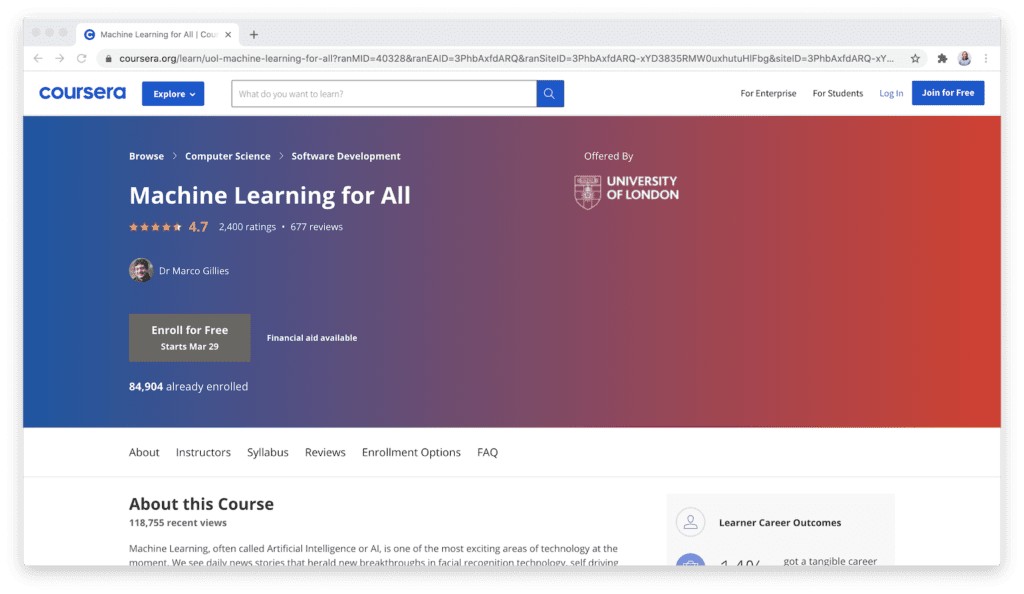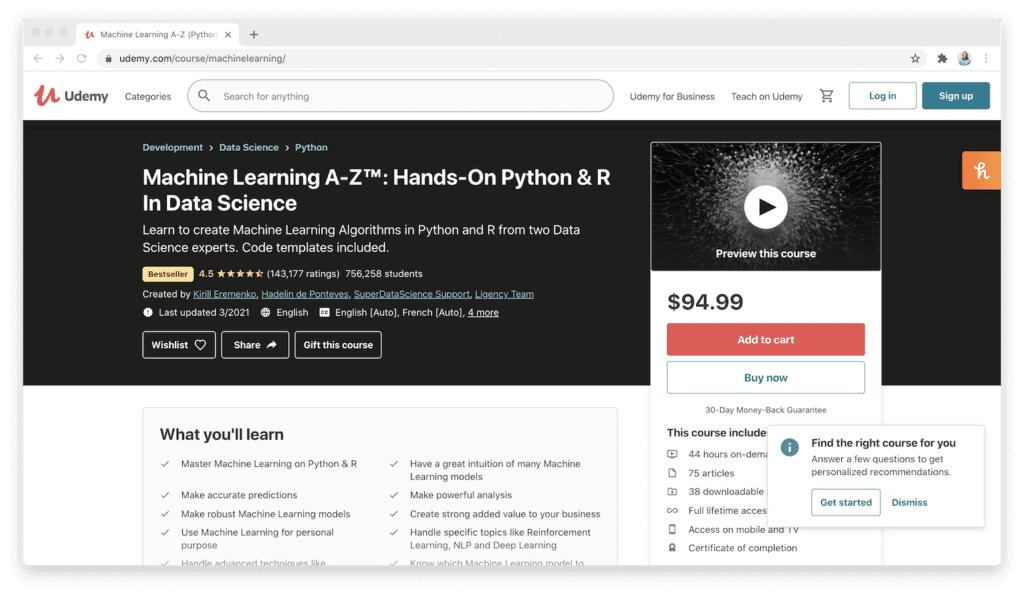All Categories
Featured
Table of Contents
- – Little Known Facts About Machine Learning Devo...
- – Things about Machine Learning (Ml) & Artificia...
- – Rumored Buzz on 19 Machine Learning Bootcamps...
- – The Basic Principles Of Machine Learning Appl...
- – The Only Guide to Machine Learning For Devel...
- – The Basic Principles Of Machine Learning Dev...
- – 3 Simple Techniques For Machine Learning Boo...
Some people believe that that's disloyalty. If somebody else did it, I'm going to use what that individual did. I'm requiring myself to think with the possible options.
Dig a little bit deeper in the mathematics at the start, simply so I can develop that foundation. Santiago: Finally, lesson number 7. I do not think that you have to recognize the nuts and screws of every algorithm before you use it.
I would certainly have to go and examine back to in fact get a much better instinct. That does not mean that I can not fix things making use of neural networks? It goes back to our arranging example I believe that's just bullshit advice.
As a designer, I've dealt with numerous, numerous systems and I have actually made use of several, several points that I do not comprehend the nuts and bolts of how it works, also though I comprehend the impact that they have. That's the last lesson on that particular string. Alexey: The amusing point is when I consider all these collections like Scikit-Learn the algorithms they use inside to implement, for instance, logistic regression or something else, are not the exact same as the formulas we research in maker knowing courses.
Little Known Facts About Machine Learning Devops Engineer.
Also if we tried to learn to get all these basics of machine understanding, at the end, the formulas that these collections use are various. Santiago: Yeah, definitely. I think we require a lot much more pragmatism in the industry.

By the means, there are two different paths. I usually talk to those that intend to function in the market that desire to have their effect there. There is a path for scientists which is completely various. I do not attempt to discuss that since I do not understand.
Right there outside, in the market, materialism goes a lengthy method for sure. Santiago: There you go, yeah. Alexey: It is a good inspirational speech.
Things about Machine Learning (Ml) & Artificial Intelligence (Ai)
One of the important things I intended to ask you. I am taking a note to speak about progressing at coding. But initially, allow's cover a number of things. (32:50) Alexey: Let's begin with core devices and frameworks that you need to learn to really shift. Allow's claim I am a software application designer.
I understand Java. I know SQL. I understand how to use Git. I understand Bash. Possibly I know Docker. All these things. And I find out about artificial intelligence, it feels like a great point. So, what are the core tools and frameworks? Yes, I watched this video and I obtain persuaded that I don't need to obtain deep into mathematics.
What are the core devices and frameworks that I need to learn to do this? (33:10) Santiago: Yeah, absolutely. Wonderful inquiry. I think, leading, you should start finding out a little bit of Python. Because you currently understand Java, I do not assume it's mosting likely to be a huge change for you.
Not because Python coincides as Java, but in a week, you're gon na obtain a lot of the differences there. You're gon na have the ability to make some progress. That's leading. (33:47) Santiago: After that you get particular core devices that are going to be utilized throughout your whole career.
Rumored Buzz on 19 Machine Learning Bootcamps & Classes To Know
You obtain SciKit Learn for the collection of device discovering formulas. Those are devices that you're going to have to be making use of. I do not suggest just going and discovering regarding them out of the blue.
Take one of those training courses that are going to begin presenting you to some issues and to some core concepts of maker discovering. I don't remember the name, however if you go to Kaggle, they have tutorials there for cost-free.
What's excellent regarding it is that the only demand for you is to recognize Python. They're going to offer a problem and inform you how to utilize choice trees to solve that certain trouble. I believe that procedure is very powerful, since you go from no maker finding out history, to comprehending what the trouble is and why you can not resolve it with what you understand today, which is straight software program engineering methods.
The Basic Principles Of Machine Learning Applied To Code Development
On the various other hand, ML designers focus on structure and deploying artificial intelligence designs. They concentrate on training designs with information to make forecasts or automate jobs. While there is overlap, AI designers manage more diverse AI applications, while ML designers have a narrower emphasis on device knowing formulas and their practical application.

Device knowing engineers focus on developing and deploying equipment knowing designs into production systems. On the other hand, information scientists have a broader function that includes data collection, cleansing, expedition, and structure designs.
As companies increasingly take on AI and artificial intelligence technologies, the demand for competent experts grows. Artificial intelligence engineers service cutting-edge projects, contribute to advancement, and have affordable salaries. However, success in this field requires constant knowing and staying on top of developing technologies and methods. Artificial intelligence functions are normally well-paid, with the possibility for high earning possibility.
ML is essentially various from conventional software application development as it focuses on teaching computer systems to gain from information, instead than shows specific guidelines that are executed systematically. Uncertainty of end results: You are most likely used to composing code with foreseeable results, whether your feature runs once or a thousand times. In ML, however, the end results are less specific.

Pre-training and fine-tuning: How these models are trained on substantial datasets and then fine-tuned for particular tasks. Applications of LLMs: Such as text generation, view evaluation and details search and retrieval.
The Only Guide to Machine Learning For Developers
The capability to take care of codebases, combine changes, and solve conflicts is simply as essential in ML development as it remains in typical software application projects. The abilities established in debugging and screening software application applications are extremely transferable. While the context might change from debugging application logic to determining issues in information handling or model training the underlying principles of systematic investigation, theory testing, and iterative refinement are the very same.
Maker knowing, at its core, is greatly dependent on data and probability theory. These are critical for understanding exactly how formulas find out from data, make forecasts, and examine their performance.
For those interested in LLMs, a complete understanding of deep learning styles is valuable. This consists of not only the mechanics of semantic networks yet likewise the style of particular versions for various use instances, like CNNs (Convolutional Neural Networks) for photo handling and RNNs (Reoccurring Neural Networks) and transformers for sequential information and all-natural language handling.
You ought to know these issues and discover methods for identifying, minimizing, and communicating about bias in ML versions. This consists of the potential influence of automated choices and the moral implications. Many models, specifically LLMs, call for significant computational sources that are frequently offered by cloud platforms like AWS, Google Cloud, and Azure.
Building these skills will certainly not just help with an effective shift right into ML yet additionally ensure that designers can contribute properly and sensibly to the development of this dynamic area. Theory is necessary, yet absolutely nothing defeats hands-on experience. Start dealing with tasks that enable you to apply what you have actually found out in a sensible context.
Construct your jobs: Start with simple applications, such as a chatbot or a text summarization device, and gradually enhance complexity. The field of ML and LLMs is quickly progressing, with new advancements and technologies emerging on a regular basis.
The Basic Principles Of Machine Learning Developer
Join areas and discussion forums, such as Reddit's r/MachineLearning or area Slack networks, to go over ideas and get suggestions. Participate in workshops, meetups, and meetings to get in touch with other experts in the area. Contribute to open-source jobs or compose post concerning your discovering journey and projects. As you obtain experience, start searching for opportunities to include ML and LLMs right into your work, or look for new duties concentrated on these modern technologies.

Vectors, matrices, and their duty in ML formulas. Terms like design, dataset, features, tags, training, inference, and validation. Data collection, preprocessing techniques, design training, examination procedures, and implementation considerations.
Decision Trees and Random Woodlands: Instinctive and interpretable versions. Support Vector Machines: Maximum margin category. Matching problem kinds with ideal models. Balancing efficiency and complexity. Basic framework of semantic networks: neurons, layers, activation features. Layered computation and forward breeding. Feedforward Networks, Convolutional Neural Networks (CNNs), Persistent Neural Networks (RNNs). Image recognition, sequence prediction, and time-series evaluation.
Constant Integration/Continuous Implementation (CI/CD) for ML process. Design tracking, versioning, and performance monitoring. Discovering and resolving modifications in design efficiency over time.
3 Simple Techniques For Machine Learning Bootcamp: Build An Ml Portfolio

You'll be introduced to three of the most pertinent parts of the AI/ML technique; managed discovering, neural networks, and deep discovering. You'll grasp the differences between typical shows and equipment understanding by hands-on growth in monitored discovering prior to developing out complicated distributed applications with neural networks.
This program functions as a guide to device lear ... Program Extra.
Table of Contents
- – Little Known Facts About Machine Learning Devo...
- – Things about Machine Learning (Ml) & Artificia...
- – Rumored Buzz on 19 Machine Learning Bootcamps...
- – The Basic Principles Of Machine Learning Appl...
- – The Only Guide to Machine Learning For Devel...
- – The Basic Principles Of Machine Learning Dev...
- – 3 Simple Techniques For Machine Learning Boo...
Latest Posts
Software Engineer Interviews: Everything You Need To Know To Succeed
Data Science Vs. Software Engineering Interviews – What’s The Difference?
The Top 50+ Software Engineering Interview Questions And Answers
More
Latest Posts
Software Engineer Interviews: Everything You Need To Know To Succeed
Data Science Vs. Software Engineering Interviews – What’s The Difference?
The Top 50+ Software Engineering Interview Questions And Answers